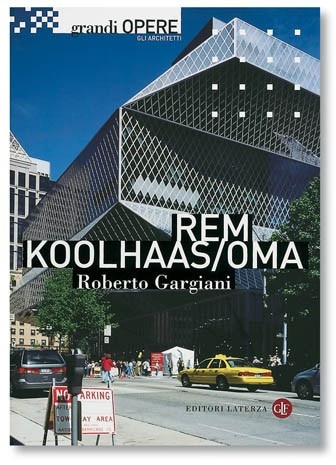Rem Koolhaas/OMA, Roberto Gargiani, Laterza, Roma-Bari 2006 (pp. 232, € 22,00)
Despite the fact that Rem Koolhaas is one of the world’s most renowned and cited architects, Italian historiography and architecture critics have scarcely explored his philosophy and the practice he has led since 1975 – the Office for Metropolitan Architecture. The designer of the Prada “epicentres” and the colossal round CCTV skyscraper in Beijing is mainly seen in Italy as the most evolved example of the archistar. This sophisticated and talented figure cannot seemingly be reduced to a critical model, except the most banal and evasive of all: someone who sells himself well. Koolhaas, for his part, has done little to dispel this reputation. As a result, in recent years the Italian press has merely promoted the persona while remaining suspicious of his theory; no one has looked beyond the persistence with which Koolhaas has, more than others, contributed towards the consumption and constant changing of his slogans. Fifteen years have passed since the only Italian monograph that has systematically addressed Koolhaas’s thinking and the work of OMA (Jacques Lucan, OMA. Rem Koolhaas, Electa, 1991). Now this book by Roberto Gargiani specifically seeks to historicise the Dutch architect’s work and take critical stock of him, in line with the customary approach of the series published by Laterza. Lacking a proper list of works, Gargiani’s monograph is rather a journey through Koolhaas’s entire architectural story. This is all the more exceptional as it displays a detailed analysis of his every transition via a rich bibliography and a simple but sophisticated body of illustrations (in keeping with the publisher’s familiar style). Thus the official suave image is exchanged for a “critical” archive one. The result is a previously unseen Koolhaas, stripped of the contemporary guru guise and described as a patient creator of his own architecture; a Koolhaas who principally refines his tools through a design practice where slogans and neologisms – of which there are plenty – serve the sole purpose of strengthening strategies. “Sperimentazioni del metodo paranoico-critico” (Experiments with the paranoiac-critical method), “New Sobriety contro Post Modern e Contextualism” (New Sobriety versus Post Modern and Contextualism), “L’epoca della ‘merveilles’” (The “merveilles” era), “Principi per una teoria dell’architettura” (Principles for a theory of architecture) and “Generic Volume, solidi poliedrici informi e diagrammi funzionali” (Generic Volume, polyhedral amorphous solids and functional diagrams) are the five chronologically ordered chapters that unpick the intricate tangle of design expedients applied by OMA in its 30-year lifespan. From the establishment of the “Dr Caligari Cabinet of Metropolitan Architecture” – the first embryo of OMA – and the projects included in Delirious New York to the recent buildings in Chicago, Berlin, Oporto and Seattle, the book is a long biography all in the historic present. This fast-moving succession of micro-stories details and references the composite strategy of Koolhaas and his practice. Weaving a thick web of links back and forth between the various projects, the author places all his evidence on the same plane, suspending the formulation of an overall judgement on the whole story or part of it. Gargiani almost seems to follow this adventure as an “embedded” historian, painstakingly recording every detail of the OMA war machine from within. He allows himself few reflections on the operational context and, above all, does not offer any views as to the efficacy of the expedients. Despite this, the book stands as a powerful diachronic X-ray of the OMA workshop. It paints a coherent picture of the practice’s work that exalts not the differences but the interdependency between design strategies, theoretical positions, construction methods and even the rendering techniques. In so doing, Gargiani provides a unitary account that implicitly attacks the very heart of the Koolhaas tactic of discontinuity. Aided by the book’s narrative structure, the author disarms the “novelty-effect”, the technique Koolhaas has always adopted to immunise his architecture against cultural fashions, detach his stylistic and formal choices from the “content” of the design action – as the latest great retrospective on OMA’s work recited – and, above all, reiterate his total acceptance of the logic of modernisation: renewal. This is why, far from being a shortcoming of the book, the picture painted by Gargiani is an ideal starting point from which to approach Koolhaas’s work. It allows us to reconstruct the many passages in a story that is often more complex than the image depicted by the albeit rich “internal” OMA monographs (simply think of the numerous 1980s OMA projects removed from S,M,L,XL). At the same time, this portrayal is the essential basis from which to launch – and not only in Italy – a real critical discourse on Koolhaas’s architecture and, above all, theory in order to separate the true strategy from the frayed propaganda mechanisms, bringing it back, for once, to this side of the good and the bad.
Gabriele Mastrigli Professor of Architectural design theory at the University of Ascoli Piceno


